Example Price List Tally Prime in Tamil
Price List in TallyPrime
The price list in the ledgers grouped under Sundry Debtors and Sundry Creditors. The selecting ledgers, the rates will appear as per the price list defined in the ledger. As to select the price list in the invoice, it makes the process of invoice entry. The term price level in the world of business. The refers to the price of assets traded on the market. The price of goods and services and is used in reference to inflation.
To simpler terms, say two companies who change prices the same products by the same amount may be different results depending they implement new policy.
Create Company
To get started with Tally Prime, you need to first create your company to keep a record of all your day-to-day business transactions. To create the company, you need the company name and financial year information. You can enter all other details such as contact information, security, while creating the company or any time later.
How to create a company in Tally Prime
- In tally, after login double click on the create company option under company information.
- Go to Top Menu -> Company -> Create -> Enter
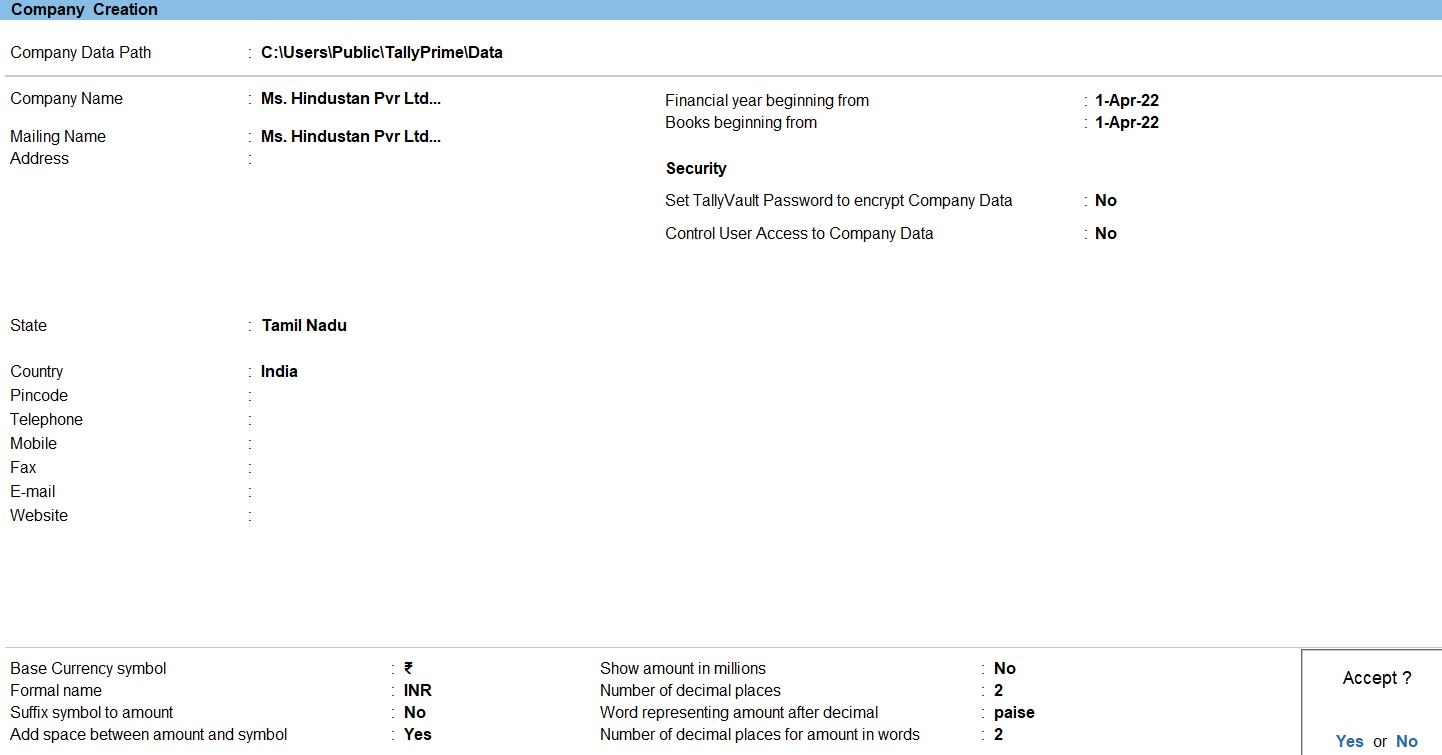
Ledger in Tally Prime
Ledgers in Tally Prime The ledgers in Tally Prime or in the Books of Accounts affect assets, liabilities, income or expenses. Tally Prime can generate a Profit & Loss A/c and Balance Sheet immediately after a transaction has been entered. It can also generate a range of comprehensive financial statements and reports.
Create a single ledger
- Press Alt+G (Go To) -> Create Master -> type or select Ledger and press Enter.
Alternatively, Gateway of Tally -> Create -> type or select Ledger and press Enter.
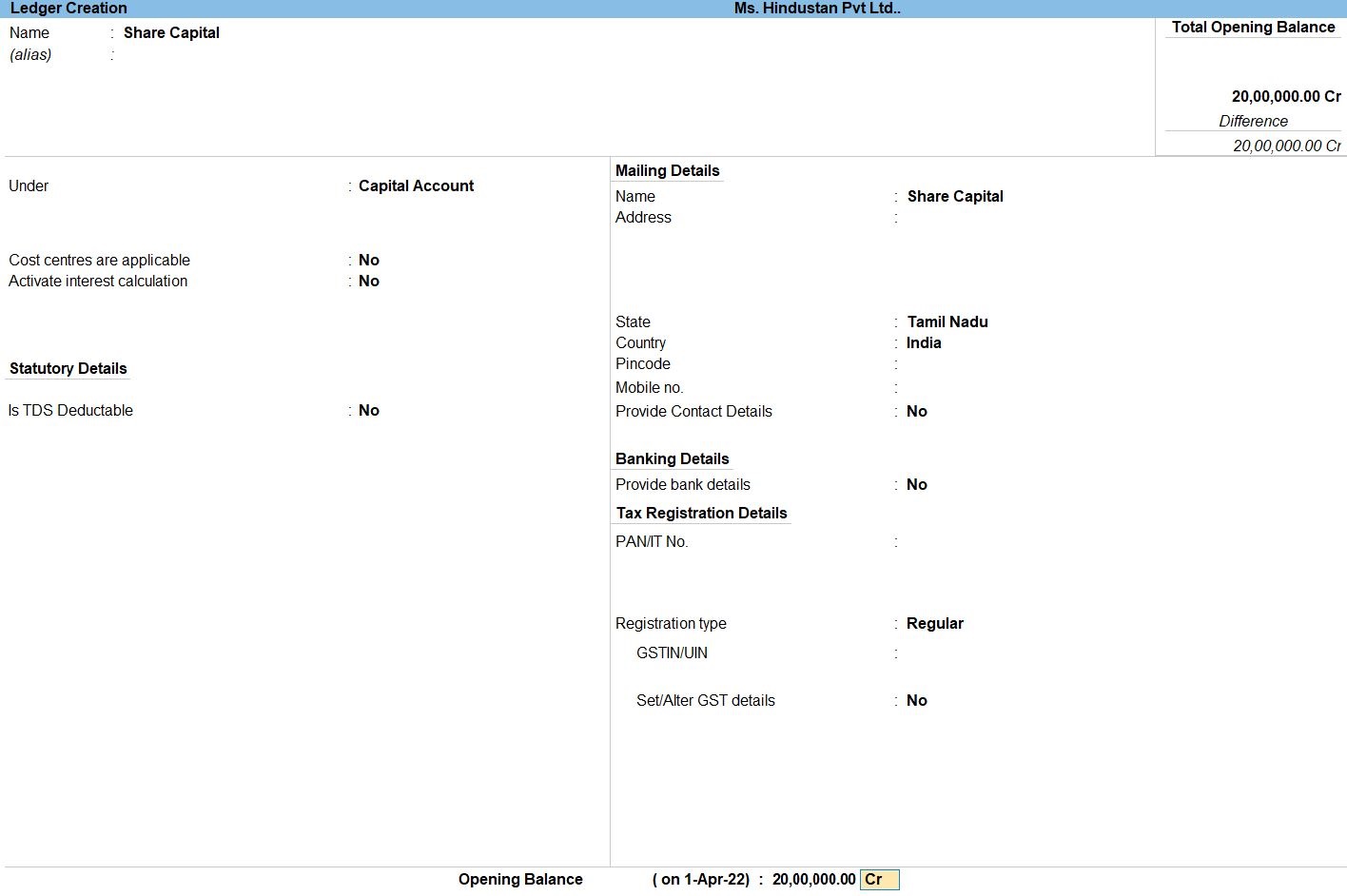
- Enter the Name of the ledger account.
Duplicate names are not allowed.
- Enter the alias of the ledger account, if required.
You can access the ledgers using the original name or the alias name
- Select a group category from the List of Groups.
- Enter the Opening Balance.
The opening balance is applicable when the ledger is an asset or a liability, and also if it has a balance in the account as on the books beginning date.
- Press Ctrl + A to save, as always
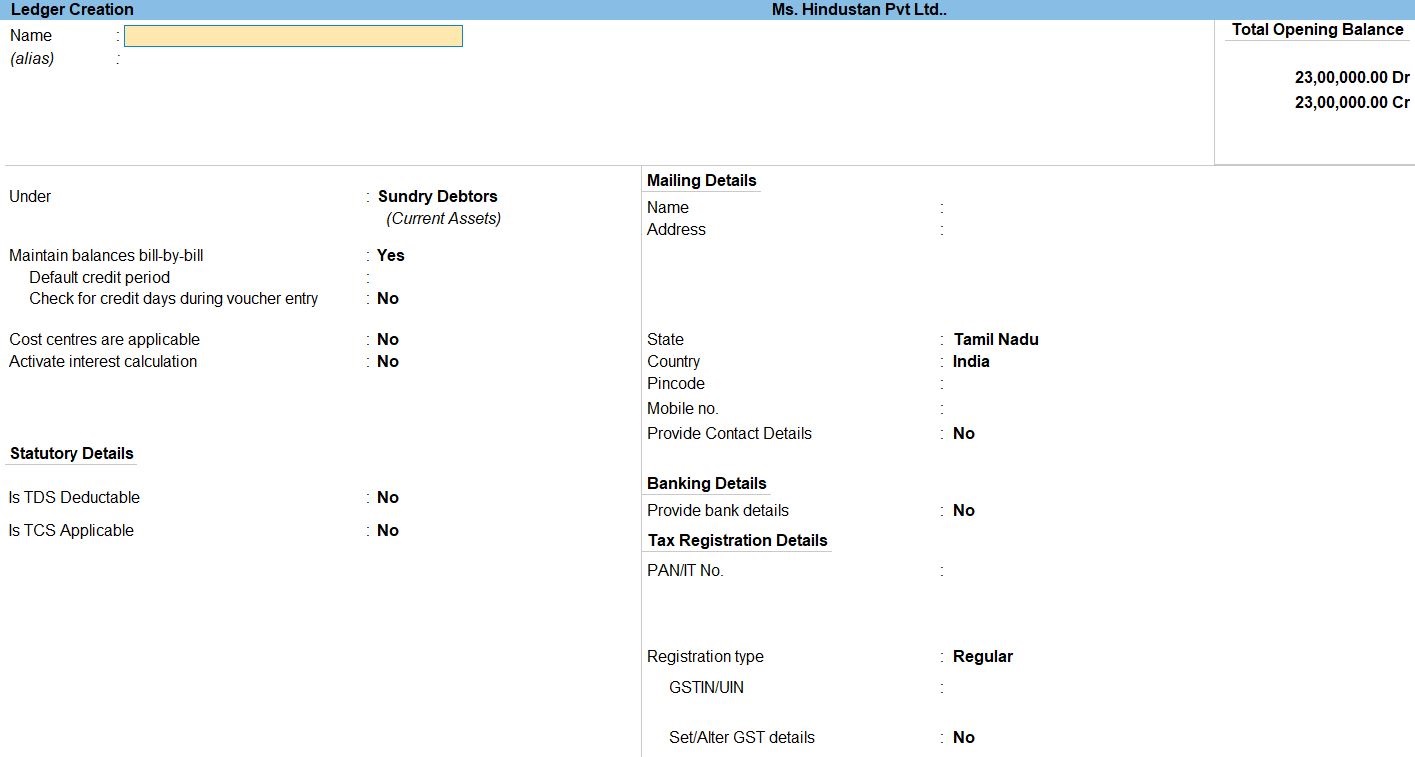
Stock Group in Tally
Stock Groups in Inventory are similar to Groups in Accounting Masters. They are helpful in the classification of Stock Items. You can group Stock Items under different Stock Groups to reflect their classification based on some common features such as brand name, product type, quality, and so on. Grouping enables you to locate Stock Items easily and report their details in statements.
Create Stock Groups
- Gateway of Tally -> Create -> type or select Stock Group and press Enter.
Alternatively, press Alt+G (Go To) -> Create Master -> type or select Stock Group -> and press Enter. - Name & alias: As in other masters, you can specify multiple aliases for the stock item.
- Under: Select Primary or an existing Stock Group. If you have not created any Stock Group, you can create one in Tally prime to assign to the stock group.As always, press Alt+C, to create a master on the fly.
Alternatively, press Alt+G (Go To) -> Create Master -> type or select Stock Group-> press Enter. - Should quantities of items be added: It pertains to information on measuring the units of the Stock Items that you would categories under the Stock Group. The Stock Items categorized under the group should have similar units for them to be added up. You cannot add quantities in Kgs to quantities in Pcs.
- Set/alter GST Details: Enable this option to define the GST rate.
- Accept the screen. As always, press Ctrl+A to Save.
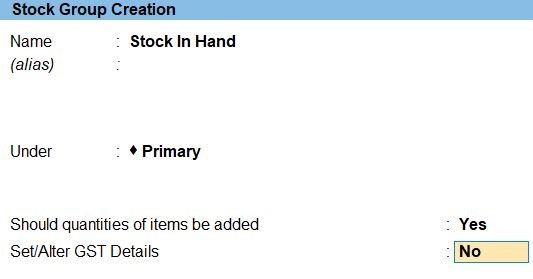
Units of Measure in Tally
Stock Items are mainly purchased and sold on the basis of quantity. The quantity in turn is measured by units. In such cases, it is necessary to create the Unit of Measure. The Units of Measure can either be simple or compound.
Examples of simple units are: nos., metres, kilograms, pieces etc.
Create Units in Tally
- Gateway of Tally -> Create -> type or select Stock unit and press Enter.
Alternatively, press Alt+G (Go To)-> Create Master-> type or select Stock Group-> and press Enter. - Enter the details in the Unit Creation screen
- Enter the Symbol. By default, the Type field will be selected as Simple
- Enter the Formal name for the simple unit.
- Select the Unit Quantity Code (UQC) relevant to the stock item from the list provided.
- The list consists of the number of Unit Quantity Codes (UQC) available for your product or commodity as declared by the Government or GSTN.
- Specify the Number of decimal places required based on your business needs.
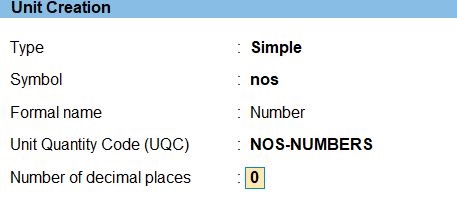
Stock Item in Tally
Stock Item refers to goods that you manufacture or trade. It is the primary inventory entity and is the lowest level of information on your inventory. You have to create a Stock Item in TallyPrime for each inventory item that you want to account for. Create stock items on-by-one.
Create Stock Item in Tally
- Go to Gateway of Tally -> Inventory Info -> Stock Item -> Stock Item creation is displayed as shown below:
- Specify the Name of the Stock Item
- Specify the Alias name of Stock Item (if required).
- The field Under will show the List of Groups. Here you can select the Stock Group to which the Stock Item belongs. By default, Primary Stock Group appears in this field.
- This field will show the Unit List. Here you can select the Unit of measurement applicable for the stock item. By default, Not Applicable appears in this field.
- Specify the details of Opening Balance, if any, for the Stock Item as on the date of Beginning of Books.
- In the Quantity Field, specify the stock item Quantity, say 300 Nos.
- In the Rate field, specify the stock item Rate, say Rs. 300 per piece.
- In the Value field, Tally Prime automatically calculates the value by multiplying the Quantity and Rate. You can also edit the value, Tally Prime automatically refreshes the Rate field accordingly.
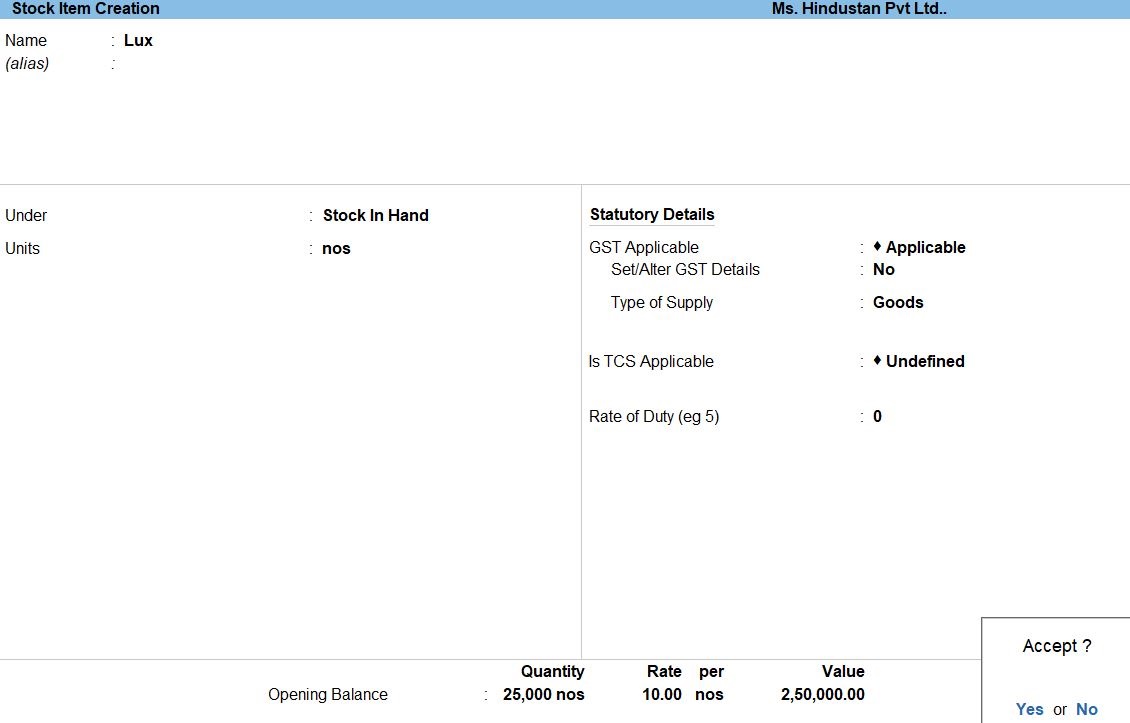
Create Price List in Tally
- Gateway of Tally -> F11 (Features) -> set Enable multiple Price Levels to Yes.If you do not see this option, set Show more features to Yes.
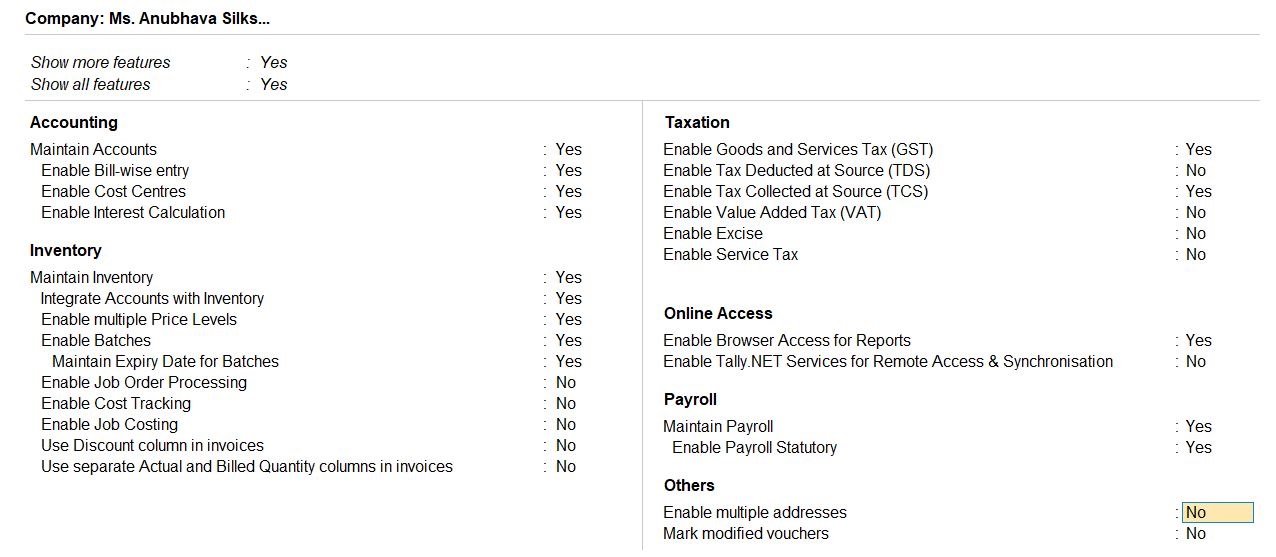
Create Price Levels in Tally
- Gateway of Tally -> Create -> Price Levels Enter.
Alternatively, press Alt+G (Go To)-> Create Master-> type or select Price Levels-> and press Enter. - Enter the details in the Price Levels screen
- Enter the Company price levels
- Enter the press Save Enter.
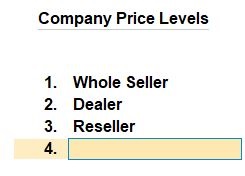
Create Price List in Tally
- Gateway of Tally -> Create -> type or select Price List (Stock Group) -> and press Enter.
- Enter the details in the Price Levels screen
- Select the Price Level, if available, otherwise, Create -> provide a name for the price level -> press Enter.
- Enter the date from which the price list is applicable.
- Enter the press Save Enter.
- Select the stock item, enter the range of quantity in From and Less than fields.
the create a stock item on the fly by using the Create option. - Enter the Rate and Discount % and press ->Enter.
- Accept the screen. As always, you can press Ctrl+A to save.

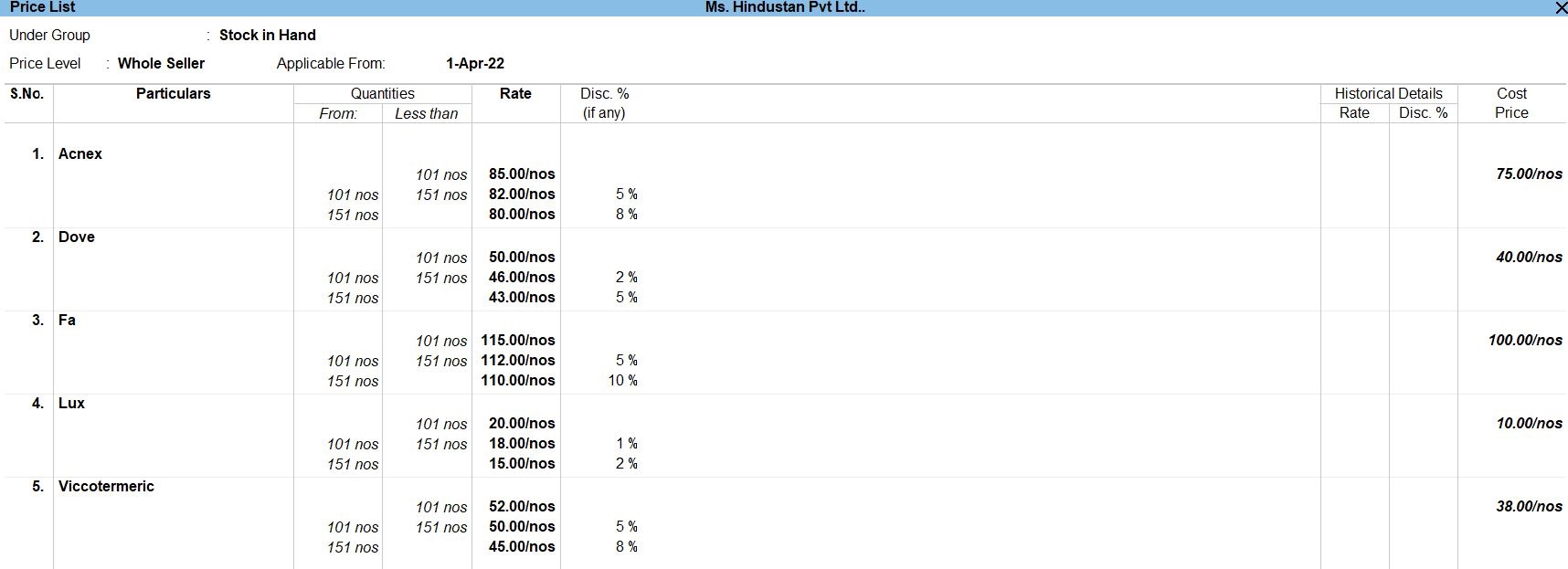
Transaction voucher in Tally Prime
Sales Voucher in Tally Prime
Whenever you sell a product or service, you record sales entries. In tally, the sales are recorded through the sales voucher. It is one of the most widely used accounting vouchers in tally. There are two modes for accounting in sales vouchers- Invoice mode and Voucher mode.
How to Use Sales Voucher in Tally Prime
- Gateway of Tally -> Voucher -> Sales Voucher(F8) or F10: Other Voucher ->Sales Voucher
Alternatively, press Alt+G (Go To) -> Create Voucher -> press F8 (Sales). - Press Ctrl+H (Change Mode) to select the required voucher mode (Item Invoice, in this case).
- Create ->Secondary ledger press Alt +C
- Create ->Party A/c Name: create the party name.
- Party Details: Provide the Dispatch, Order, and Buyer details as per your invoice requirements.
the Party Details screen, press F12 (Configure), and set Provide Dispatch, Order, and Export details to Yes. - Enter discount coulem activated in F11 -> Use Discount column in invoices Yes
- Enter the Quantity. The Rate defined in the price list linked to the price level.
- Accept the screen. As always, press Ctrl+A to Save.

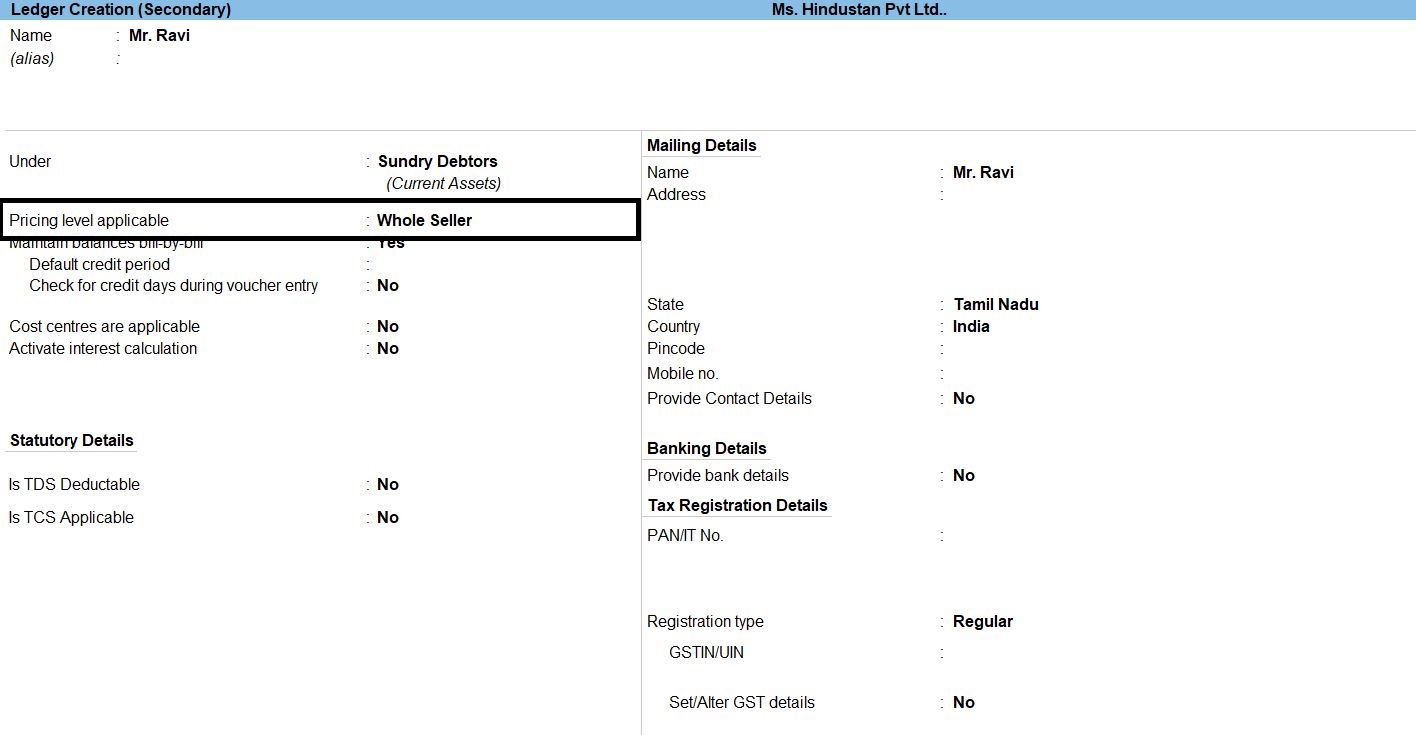
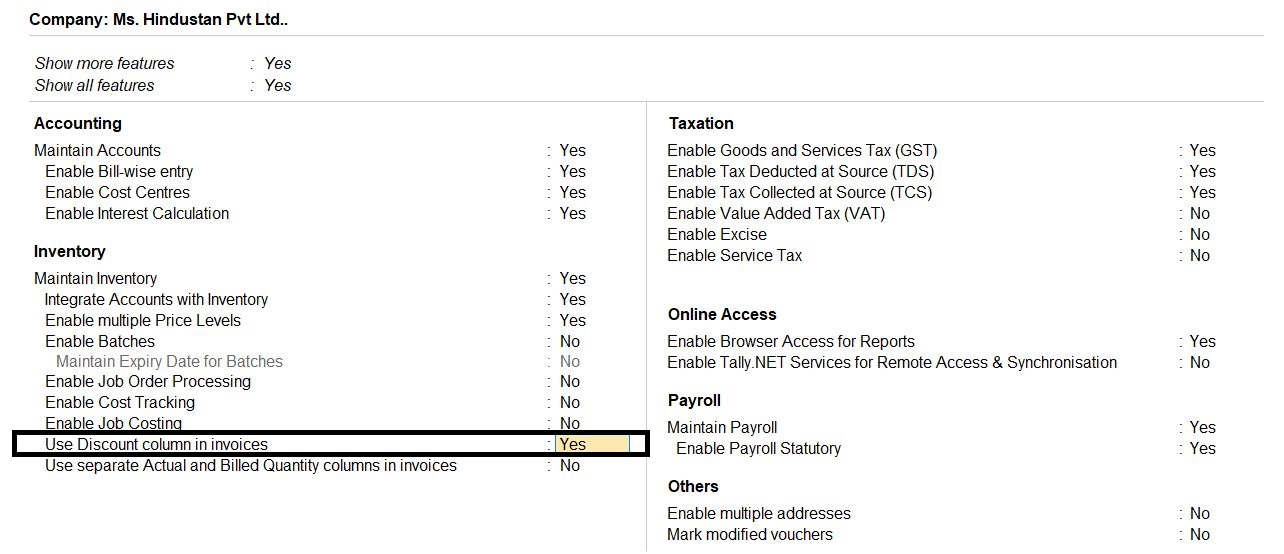

follow the above steps for following transaction.
May2 Goods Purchased From Mr.Vijay For The Following Item
- Dove 350nos
- Power 50nos
- Viccotermeric 200nos
- Acnes 500nos
Trade Discount 4% Bill No: 123 (30days)
May 31 Goods Sold To Mr.Lovely Ltd (Dealer) For The Following Items
- Acnex 100nos, 150nos, 200nos
- Lux 100nos, 150nos, 200nos
Sales Tax 10% Bill No:425 20(Days)
Aug 3 Goods Sold To Mr.Meera For The Following.
- Sinthol 1500nos @ Rs.20each
- Mysore Sandal 1000nos @ Rs.15each
- Chandrika 3000nos @ Rs.15each
Sale Tax 5% Vide Bill No:MR58 (15days)
Purchase Voucher in Tally Prime
Whenever you purchase a product or service, you record the purchase entry. In tally, this is recorded through the purchase voucher. It is also one of the most widely used vouchers in tally. There are two modes for accounting in purchase vouchers- Invoice mode and Voucher mode, as mentioned in the sales voucher
You may do a simple cash purchase or purchase on credit. For each purchase transaction, you will need to keep a record of the items you bought, payments made, goods returned, and so on.
How to Use Purchase Voucher in Tally Prime
- Gateway of Tally -> Voucher -> Purchase Voucher(F9) or F10: Other Voucher ->Purchase Voucher
Alternatively, press Alt+G (Go To) -> Create Voucher -> press F8 (Purchase). - Press Ctrl+H (Change Mode) to select the required voucher mode (Item Invoice, in this case).
- Create ->Secondary ledger press Alt +C
- Create ->Party A/c Name: create the party name.
- Party Details: Provide the Dispatch, Order, and Buyer details as per your invoice requirements.
the Party Details screen, press F12 (Configure), and set Provide Dispatch, Order, and Export details to Yes. - Enter the Quantity. The Rate defined in the price list linked to the price level.
- Accept the screen. As always, press Ctrl+A to Save.

Receipt Voucher in Tally Prime
The receipt is the act of receiving, or the fact of having been received while voucher is a piece of paper that entitles the holder to a discount, or that can be exchanged for goods and services.
Receipt voucher- It is also called a credit voucher. A receipt voucher is used to keep a record of cash or bank receipt.
- Gateway of Tally -> Voucher -> Receipt Voucher(F6) or F10: Other Voucher -> Receipt Voucher
- Create ->Secondary ledger press Alt +C
- Accept the screen. As always, press Ctrl+A to Save.
- Enter to Save the entry

Credit Note Voucher in Tally Prime
Credit Note entry is passed when there is a sales return transaction. This voucher usually remains deactivated by default. You can activate it by pressing F11 and configuring features in invoicing. You can refer to the original sales invoice against which this entry is passed to keep track of such transactions.
How to Use Debit Note in Tally Prime
- Gateway of Tally -> Voucher -> Credit Note Voucher(F9) or F10: Other Voucher ->Credit Note Voucher
- Credit Note then select Change voucher mode (Ctrl+H) -> select Item Invoice Enter
- Enter the Party to be Select party name Ledger
- Enter the name of item from select the Stock Items List
- Enter the Quantity and Rate,and the amount is automatically displayed in the Amount field.
- Accept the screen. As always, press Ctrl+A to Save.

Journal Voucher in Tally Prime
The equivalent back up document for a transaction not involving the movement of money is called a journal voucher. Examples of 'non-cash' transactions include to recognize a donation in kind of a computer, to correct a coding error in a previous closed month, to charge interest on a loan or depreciate fixed assets.
How to Use Journal Voucher in Tally Prime
- Gateway of Tally -> Voucher -> Journal Voucher(F7)Voucher or F10: Other VoucherVoucher -> Journal Voucher
- Create ->Secondary ledger press Alt +C
- Accept the screen. As always, press Ctrl+A to Save.

Stock Journal in Tally Prime
Closing stock lying in the dealer unit on 31st March 2014 up to the date of registration as Importer, has to be transferred to importer unit as opening stock using voucher class created for stock transfer in stock journal voucher. From the books beginning date with dealer registration till the date of registration as Importer, the complete stock has to be transferred to importer unit
If goods are purchased to importer unit, the stock journal voucher class need not be used.In the closing stock of goods lying in dealer unit, the goods invoiced with Nature of Purchase as Importer can be transferred to importer unit as opening stock
- Gateway of Tally -> Vouchers -> press F10 (Other Vouchers) -> type or select Stock Journal.
Alternatively, press Alt+G (Go To) -> Create Voucher -> press F10 (Other Vouchers) -> type or select Stock Journal. - Select the Stock Items List
- Enter the Quantity and Rate,and the amount is automatically displayed in the Amount field.
- Accept the screen. As always, press Ctrl+A to save.

Profit and Loss In TallyPrime
Profit and Loss A/c is one of the primary financial statements that you can use to monitor the health of your business. It summarizes the revenues, costs, and expenses for a specific period, such as a quarter or a year. Thus, you can easily gather the net result of the business operations.
Using the Profit and Loss A/c in Tally Prime, you can measure the ability of your business to generate profit. Accordingly, you can take various measures to increase revenue, reduce costs, and so on. What’s more, you can view the Profit and Loss A/c in the browser.
How to Use Profit and Loss in Tally Prime
- Gateway of Tally -> Report -> Profit & Loss A/C (F1)

Balance Sheet In TallyPrime
Balance Sheet is one of topmost financial statement prepared by the businesses. The financial details of the balance sheet help you and the external stakeholders to evaluate the financial performance of the business on a given date. Before knowing the steps to prepare a balance sheet and reading the balance sheet, it is important to be familiar with the components and format of the balance sheet.
- Gateway of Tally -> Report -> Balance Sheet (F1)
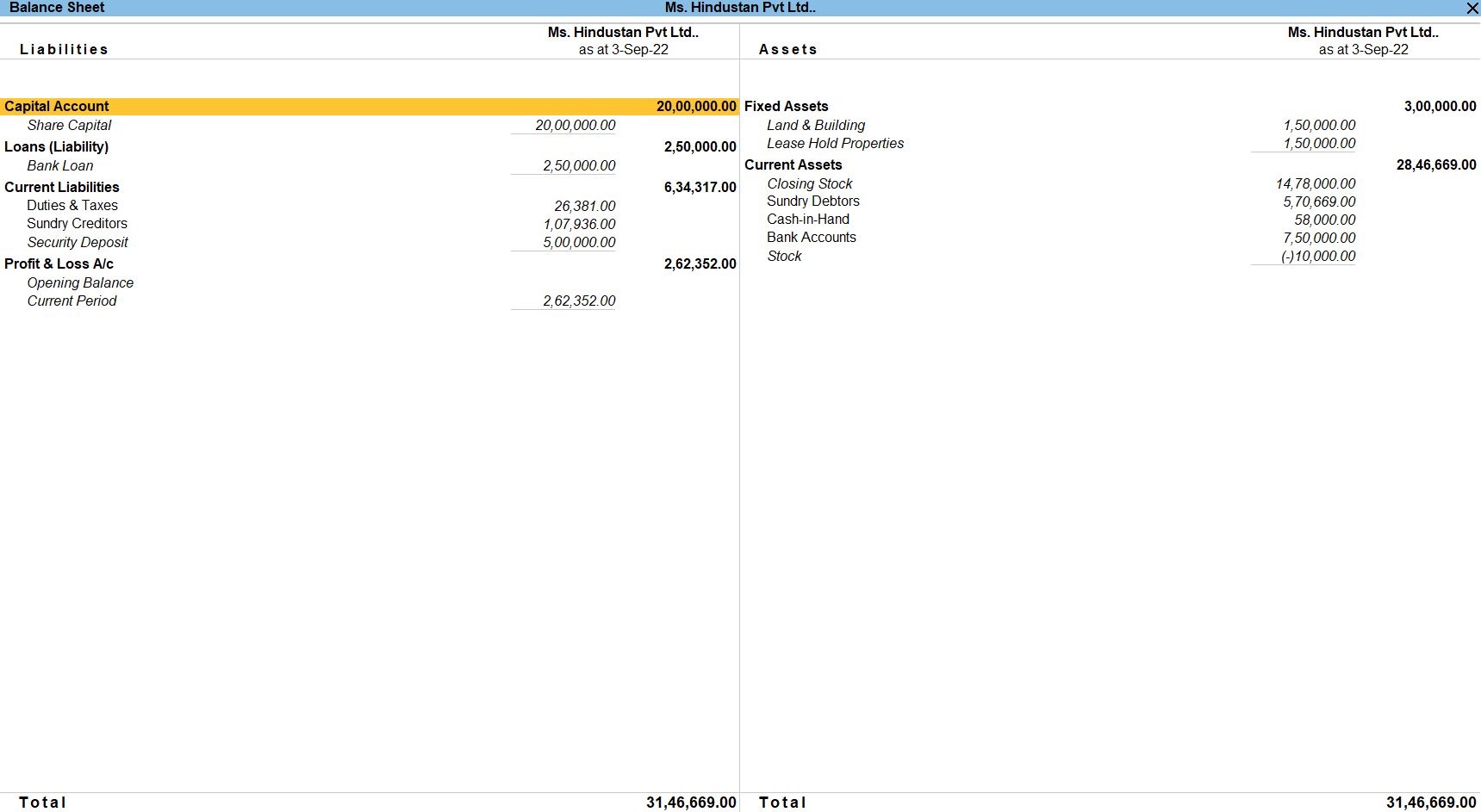
Tally Prime
Learn All in Tamil © Designed & Developed By Tutor Joes | Privacy Policy | Terms & Conditions